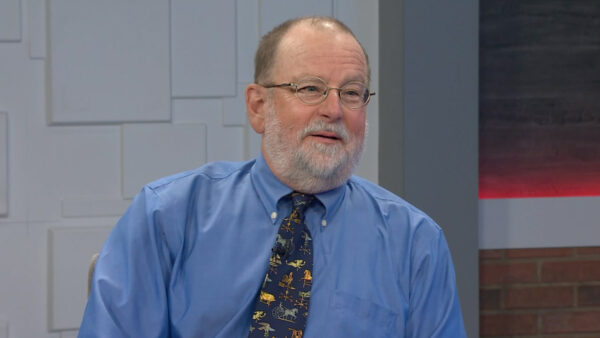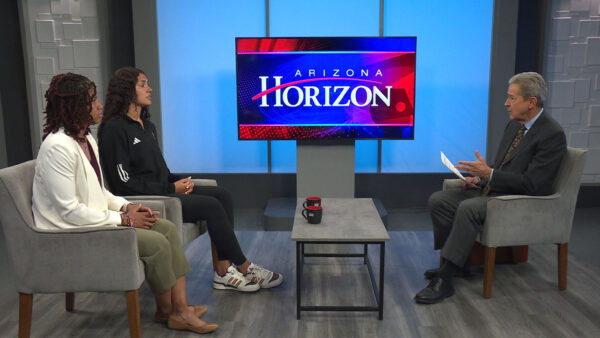More than one million Arizonans will be impacted by cuts starting November 1 in the Supplemental Nutrition Assistance Program, otherwise known as food stamps. Cynthia Zwick, executive director of Arizona Community Action Association, will talk about how the cuts will impact Arizonans.
Ted Simons: Starting tomorrow, more than 1 million Arizonans will be impacted by cuts in the supplemental nutrition assistance program, otherwise known as food stamps. Joining me now is Cynthia Zwick, executive director of the Arizona Community Action Association. It's good to have you here. When we talk about food stamps, we hear food stamps, we hear SNAP, what is SNAP? One and the same?
Cynthia Zwick: They are the same program. SNAP is the new name for food stamps and it stand for Supplemental Nutrition Assistance Program.
Ted Simons: And there was a temporary boost back in 2009. Correct?
Cynthia Zwick: There was. It was part of the stimulus that was the recovery act program, and there was a significant increase to the program at that time.
Ted Simons: And the concern now is that that temporary boost ends tomorrow.
Cynthia Zwick: It ends tomorrow, which means every individual who's currently on food stamps in Arizona today or on the SNAP program, will see a reduction in the benefit they receive.
Ted Simons: And how many again in Arizona?
Cynthia Zwick: There's 1.1 million Arizonans on the SNAP program today, which is one of the highest numbers we've seen over time. And it is in direct response to a number of factors, but obviously coming out of the recession, more and more families are struggling, and enrolled in the program for help.
Ted Simons: Talk to us about kids. How many kids included in that and/or other numbers?
Cynthia Zwick: I don't have the exact number for the kids, but the households that are receiving SNAP, of those households, about 70% are seniors, children, and disabled families. So it's significant. About 50% of the enrollees are children.
Ted Simons: And about 109 or some-odd million cut from SNAP benefits to Arizona.
Cynthia Zwick: That's right.
Ted Simons: What does that mean to every person receiving the increased amount of food stamp money now, or the food stamps now? What were they getting, what are they getting now, what's going to happen tomorrow?
Cynthia Zwick: The average -- The program doesn't help a family completely feed it. It is supplemental, so it doesn't completely take care of food needs. Right now the average benefit on a monthly basis is $125. So what that really averages out to is about $4.19 a day, or $1.37 a meal. So what's going to happen at the end of this -- At the end of this day is tomorrow essentially a family of four will see a $36 cut, which works -- A month, which works out to 20 meals a month for that family. They're not no longer going to be able to purchase 20 meals.
Ted Simons: In terms of percent, 7-10%?
Cynthia Zwick: Yeah. It's about 7% I believe.
Ted Simons: So -- What are they based on? Is it just across the board? Household size? What goes on here?
Cynthia Zwick: The cut is essentially the reduction in the increase through the stimulus fund. So all of that is being wiped out. But they're doing it -- The percentage is based on the number of people in a home, or the number of people receiving food stamps in that home. So for a single person they're going to see an $11 reduction for a month. And up to the $36 for a family of four.
Ted Simons: What kind of assistance will be out there for these? Meals on wheels, food banks and those things?
Cynthia Zwick: So here's the difficulty. This is a first step in potential cuts. So if Congress enacts additional cuts through the Farm Act, Farm bill that's sometime pending in Congress, there could be additional cuts. The programs that are currently in place have seen reductions over time, and so they're really -- there are inadequate resources to feed these families. So people will turn to food banks, which are already struggling with capacity, and enough food to serve families. They'll be turning to charities, churches, they'll be turning to other resources. The reality is, though, that as the families in need continue to either grow or be sustained, the resources are being cut. So there will not be enough to go around.
Ted Simons: You mentioned the new farm bill. It sounds as though deeper cuts really are in the offing here. How much will they cut below the 2009 level before this temporary boost happened?
Cynthia Zwick: They're looking at cutting another $5 billion in the next fiscal year, and another 11 billion dollars for the next two years. So another $16 billion is going to be reduced from the current funding, which will significantly reduce, again, the number of people who are able to receive the benefit and the level of benefit that is available.
Ted Simons: What we're hearing from Washington, and these are arguments on the other side regarding SNAP and saying, first of all, this was a temporary boost because of the dire situation back in 2009, never meant to be permanent, it's time now to go ahead back to those levels or the farm bill dictates, even previous to that. What do you say?
Cynthia Zwick: I say that's going to create huge hardship for families across Arizona and across this country. Here's part of the problem. All of those families are that lost their jobs or became under employed during the recession are not fully employed. We still have an 8% unemployment rate in Arizona. They're making minimum wage or they're underemployed so they're not working full-time. Or they're working two part-time jobs but making minimum wage. So they still don't have the resources to support their families. And the SNAP program is intended to be a temporary program, and on average across the country, it's about a nine-month enrollment. In Arizona it's about two years now. So it's gone up because our economy has not completely recovered, there are still too many people that can't support their families and they're still struggling to make ends meet.
Ted Simons: Once again, to give you an argument from the other side, that is that SNAP is -- I've heard this said, it's a disincentive for those who receive SNAP, it's a disincentive for those on food stamps to get a better job.
Cynthia Zwick: I don't agree with that. What I would say to those folks, these are hard-working people, working one or two jobs, most of the people on food stamps are employed. And it's $4 a day. I don't know that anybody is going to turn away a good job in order to reach the $4 a day supplement. But the other thing that's happened is, if folks are trying to go back to work, many of the support systems that are in place or had been in place in Arizona, things like child care, temporary assistance for needy families, emergency services, all of those funds have been cut. So there are a lot of barriers for people being able to get back to work fully, sustain their families without some support. And this program provides support. I'd also like to mention that for every $5 of SNAP money that comes into the state and is expended into this communicated, it's a return of about $9. So investment in that program really is a benefit to the economy ultimately.
Ted Simons: So as far as what you want to see done, do you want to see at least back to the 2009 levels? If not that, obviously you want to see this temporary increase stay until -- What parameters would make sense, OK, now we can roll this back? Because you got -- In D.C. they're looking for ways to roll back the budget.
Cynthia Zwick: I know they are. And I think part of the problem is they're looking for ways to roll back the budget on the backs of people who don't have the resources currently to support themselves. And so what we're asking for is that this money be restored after tomorrow. If that is not possible, we're asking for no future cuts to come along until the economy really turns around and people are able to sustain themselves and find work that can support their families. And we'll be able to see that, because this program is sort of countercyclical: as people begin to do better they'll fall off the rolls and the enrollment will drop. So during the recession we were seeing about 600,000 people, 500,000 people and it's climbed to the 1.1 million. So it's been direct response to a difficult situation.
Ted Simons: And we're still not seeing that ease off much at all?
Cynthia Zwick: We're not yet, in Arizona, seeing that ease off. We are seeing many -- We know things are starting to turn around or we're hearing things are starting to turn around in the housing market and other places, but I will tell you for poor families who are working at minimum wage and as I said, are underemployed, working part-time, they're not seeing a turnaround yet.
Ted Simons: Last question, as far as state lawmakers are concerned, and state leaders, what do you need to see regarding support services?
Cynthia Zwick: We need the restoration of funds to the safety net programs, and we need to see some policies and modifications in the public policy to support families getting back to work.
Ted Simons: All right. Thank you so much for joining us.
Cynthia Zwick: Thank you.
Cynthia Zwick:Executive Director, Arizona Community Action Association;




















